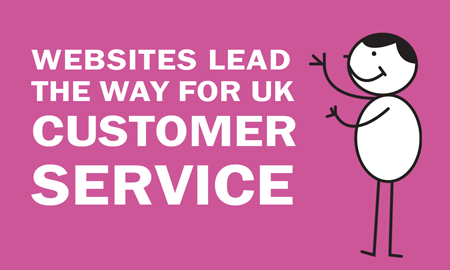Websites lead the way for UK customer service

With an increasing amount of our time spent online, company websites are now more often than not the first port of call for consumers looking for information from brands. Being able to find answers to their questions quickly is therefore a vital part of the customer experience.
According to the latest Eptica Multichannel Customer Experience Study, the good news is that most companies understand this, with the web remaining the strongest channel for providing accurate answers to consumer queries. However, the study also highlights that accuracy varies hugely between sectors and companies, ranging from 100% down to just 5%. In turn, the study found that this has led to an average of 66% of questions successfully answered, meaning a third of consumers are left disappointed.
Since 2001 Eptica has evaluated 100 leading UK companies on their ability to provide answers to 10 routine questions via the web as well as their speed and accuracy when responding to emails, Twitter, Facebook and web chat. The web, in the form of help and self service has remained on top throughout that time and continued to improve between 2015 and 2016.
Average performance becomes the norm?
However, when looking at individual companies and sectors, there’s a growing gap separating the top performers from the others; with the bulk of companies sitting in the middle. So for example 11% of the brands evaluated scored a maximum 100% by answering all questions successfully, while 10% of those surveyed managed to answer only 40% or less. Over half (53%) of the companies were stuck between 40-70% successfully delivered answers.
The difference in performance within individual sectors is also worth highlighting – one entertainment retailer scored 100% and another 5% (failing to fully answer any questions at all). In competitive markets such as entertainment, with multiple companies selling the same or similar products failing to deliver accurate, responsive customer service will quickly hit the bottom line as consumers opt to purchase products from brands that deliver a far superior experience.
The Study also found that some sectors are clearly way ahead of others in terms of the web experience they deliver. For example, even the worst performing companies in banking and fashion scored 70%, still significantly better than the top performers in insurance who managed to successfully answer only 60% of questions.
Banking tops the table
In 2015, the study highlighted the big improvement made by banking sector websites (an overall online score of 91% for the sector), overtaking sites operated by fashion retailers. Banking held on to its top spot this year, but its score slipped to 84%, narrowly beating fashion (83.5%). The biggest positive strides this year came from utility companies for whom the average score jumped 15%, from 66% to 81% quite possibly due to recent press about poor customer service in this sector.
On the negative side, five out of ten sectors performed worse than in 2015, with the average score for consumer electronics manufacturers slipping 10%. Entertainment retailers propped up the bottom of the table, dropping 8% since 2015, to a score of just 57%.
The power of self-service
Interestingly, this year we saw a big jump in number of companies offering web self-service -available on 68% of websites, up from 56% surveyed in 2015. In fact the presence of web self-service closely correlates to improved scores in the study when looking at the different sectors. For example all the banks and utilities offer web self-service, but just 30% of entertainment retailers provided this service to their customers.
Self-service is an attractive channel to both the public and businesses. Consumers can find answers easily during their web journey on a site without having to pick up the phone or send an email, while businesses increase efficiency as queries answered via self-service reduce costs bydeflecting calls or emails to the contact center. Demonstrating this trend, research from Forrester found that more people are now using self-service than are calling an organization.
The rise of the mobile web, the growing buying power of new ‘internet native’ generations, as well as older demographics spending more time online, means company websites are becoming ever more important. So it’s essential that brands continually invest in improving self-service functionality and experience they offer in order to satisfy and retain customers moving forward.







Comments